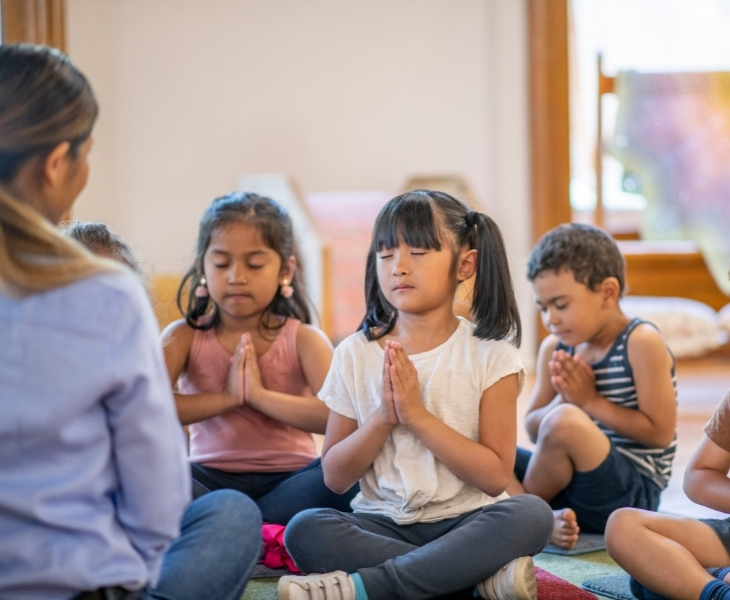What is Mindfulness in the Classroom?
Mindfulness has become a bit of a buzzword in recent years, and it has been implemented in workplaces all over the world to improve staff performance, emotional management, and stress reduction. With the World Health Organization predicting that mental health issues will be the greatest burden on healthcare resources by 2030, many see implementing mindfulness as part of the solution and an effective antidote to modern life’s stress and anxiety issues.
These benefits are overwhelmingly inspiring more workplaces and motivating schools around the world to use “mindfulness” as a tool to improve students’ overall well-being, concentration, and academic performance. Mindfulness has been linked to improved emotional well-being and self-compassion. According to researchers from Deakin University and InsightSRC, implementing a mindfulness program in schools can directly contribute to improved mental health, fewer classroom disruptions, emotional benefits, early childhood development, and student engagement. Here are some ways to easily include mindfulness into your curriculum and bring some calm to your classroom.
How to Implement Mindfulness in the Classroom
1. Create a Safe and Quiet Space
Designate a quiet space in the classroom, where students can go when they feel overwhelmed by the chaos of their surroundings. This can help them to have their own time and space to calm their emotions and reflect upon themselves, which helps in developing self-awareness and promoting positive behaviour. Try to keep the space minimal with few distractions; a bean bag, a small desk, and a blanket to encourage them to sit or lie down comfortably. Decorate the space with stuffed toys or add some calming tools like stress balls, play-doh, glitter jars, or kinetic sand to help in regulating their emotions.
2. Practice Daily Journaling
Ask your students to keep a daily journal of their mental, physical, and emotional experiences. Mindful journaling can help them reflect on their day by focusing on their accomplishments and shortcomings. Allow them some time before each lesson to reflect on how they are feeling to relieve stress and gain clarity to help them learn with complete focus and a positive mindset.
3. Check-in on Them
Creating a strong sense of belonging in students is crucial in every classroom. Create a weekly or daily routine for group sessions in which you check-in with your students and allow them to share their thoughts and feelings with the group. This will help students know that their feelings and emotions are valued and heard, which can lead to feelings of acceptance, respect, inclusion, and support in a learning environment.
4. Practice Gratitude
Gratitude is an essential mindfulness practice that we should all incorporate into our daily lives and is an extremely important part of mindfulness in the classroom. Being grateful is an essential component of cultivating mindfulness in young minds. Set aside the last 5-minutes of class for students to write down what they are thankful for, allow them to share their thoughts briefly with a classmate, or let them think about it silently.
5. Introducing Mindful Activities
Incorporating mindfulness activities into the everyday classroom can help reduce stress, boost concentration, improve social skills, and develop problem-solving, and decision-making skills. According to a Mindful Schools study, 83 percent of students who used mindfulness techniques in the classroom helped to improve their focus. Daily 5-10 minute mindfulness practices can help cultivate a sense of inner peace and improve your students’ learning experience.
Creating a Mindfulness Jar
Creating a glitter mason jar is a great stress reliever and a fun craft project to do with your students. The Calming Glitter Jar is a tried-and-true mindfulness tool that can help both children and adults of all ages relax.
· Fill a mason jar with water, leaving 2-3 cm of space at the top
· Add a generous amount of glitter glue to the jar (a combination of PVC glue and regular glitter)
· Seal the bottle and shake it well to mix the glitter, water, and glue
· Now ask students to imagine the glitter as their thoughts when they’re stressed, angry, or upset. See how the glitter whirls around, making it difficult to see clearly – this will help to explain negative feelings and emotions in a way young children can understand.
Mindful Colouring
When students feel isolated or misunderstood in the classroom, stress and anxiety can arise. Finding ways to get them to collaborate and work together will provide them with more opportunities to connect, feel heard, and seen. Take a large sheet of paper, markers, painting colours, crayons, or pencils, and have the entire class collaborate to create a magnificent piece of art.
Walking Meditations
This mindful practice is best done outside of the classroom in a large space, where students can have their own space and peace. Begin the walking meditation by
having students take some deep breaths with their eyes closed, then slowly walk forwards while noticing their body sensations and how the world around them feels.
Mindfulness in the classroom is all about being open to learning something new, letting go of judgement, embarking on a journey of self-discovery, and enjoying the present moment. Dedicating some time to implementing mindfulness in the classroom can help students grow emotionally, socially, and academically.

